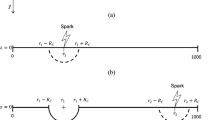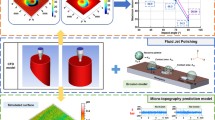Abstract
Extensive efforts (mathematical, numerical, and analytical) have been earlier tried to replicate the EDM process in its true nature. In the present work, the surface roughness (Ra) of the electrical discharge textured Ti6Al4V has got mathematically modeled. The parametric influence on the morphology of the developed craters got elucidated at distinct process conditions. The influential factors, viz. current (I, 2–10 A) and pulse on time (Ton, 100–300 μs), were varied to conduct a full factorial set of simulations and experimentations, keeping voltage (V, 30 V) as a constant. The I and V possessed dominant influence for material removal along the radial and axial directions (respectively), whereas the impact of Ton remained uniform in both the directions. Besides, two distinct considerations (based on the positioning of multi-overlapping craters) for prediction of Ra got proposed; the secondary craters superimposing with the primary along its circumference were found to fetch convincing results [with a maximum possible error (average) of 16%]. Simulation and experimentation results were compared using Ra data, crater morphological images, and radius to depth ratio (Rrd) plots. The outcomes were in close concordance with acceptable tolerances. The variation got attributed to the uncontrollable/disregarded factors (formation of recast layer and short circuit ensuing debris interference), prevalent in the case of in situ work environments.





















Similar content being viewed by others
References
Dilip DG, Ananthan SP, Panda S, Mathew J (2019) Numerical simulation of the influence of fluid motion in mushy zone during micro-EDM on the crater surface profile of Inconel 718 alloy. J Braz Soc Mech Sci Eng 41:107. https://doi.org/10.1007/s40430-019-1595-0
Das S, Klotz M, Klocke F (2003) EDM simulation: finite element-based calculation of deformation, microstructure and residual stresses. J Mater Process Technol 142:434–451. https://doi.org/10.1016/S0924-0136(03)00624-1
Singh A, Ghosh A (1999) A thermo-electric model of material removal during electric discharge machining. Int J Mach Tools Manuf 39:669–682. https://doi.org/10.1016/S0890-6955(98)00047-9
Tariq Jilani S, Pandey PC (1982) Analysis and modelling of edm parameters. Precis Eng 4:215–221. https://doi.org/10.1016/0141-6359(82)90011-3
Tariq Jilani S, Pandey PC (1983) An analysis of surface erosion in electrical discharge machining. Wear 84:275–284. https://doi.org/10.1016/0043-1648(83)90269-7
van Dijck FS, Dutré WL (1974) Heat conduction model for the calculation of the volume of molten metal in electric discharges. J Phys D Appl Phys 7:316. https://doi.org/10.1088/0022-3727/7/6/316
Yang X, Guo J, Chen X, Kunieda M (2011) Molecular dynamics simulation of the material removal mechanism in micro-EDM. Precis Eng 35:51–57. https://doi.org/10.1016/j.precisioneng.2010.09.005
DiBitonto DD, Eubank PT, Patel MR, Barrufet MA (1989) Theoretical models of the electrical discharge machining process. I. A simple cathode erosion model. J Appl Phys 66:4095–4103. https://doi.org/10.1063/1.343994
Patel MR, Barrufet MA, Eubank PT, DiBitonto DD (1989) Theoretical models of the electrical discharge machining process. II. The anode erosion model. J Appl Phys 66:4104–4111. https://doi.org/10.1063/1.343995
Joshi SN, Pande SS (2010) Thermo-physical modeling of die-sinking EDM process. J Manuf Process 12:45–56. https://doi.org/10.1016/j.jmapro.2010.02.001
Jithin S, Bhandarkar UV, Joshi SS (2017) Analytical simulation of random textures generated in electrical discharge texturing. J Manuf Sci Eng 139:111002. https://doi.org/10.1115/1.4037322
Izquierdo B, Sánchez JA, Plaza S, Pombo I, Ortega N (2009) A numerical model of the EDM process considering the effect of multiple discharges. Int J Mach Tools Manuf 49:220–229. https://doi.org/10.1016/j.ijmachtools.2008.11.003
Izquierdo B, Plaza S, Sánchez JA, Pombo I, Ortega N (2012) Numerical prediction of heat affected layer in the EDM of aeronautical alloys. Appl Surf Sci 259:780–790. https://doi.org/10.1016/j.apsusc.2012.07.124
Salonitis K, Stournaras A, Stavropoulos P, Chryssolouris G (2009) Thermal modeling of the material removal rate and surface roughness for die-sinking EDM. Int J Adv Manuf Technol 40:316–323. https://doi.org/10.1007/s00170-007-1327-y
Descoeudres A (2006) Characterization of electrical discharge machining plasmas. https://doi.org/10.5075/epfl-thesis-354
Ashok Raj J, Pottirayil A, Kailas SV (2016) Dry sliding wear behavior of Ti–6Al–4V pin against SS316L disk at constant contact pressure. J Tribol 139:021603. https://doi.org/10.1115/1.4033363
Harcuba P, Bačáková L, Stráský J, Bačáková M, Novotná K, Janeček M (2012) Surface treatment by electric discharge machining of Ti–6Al–4V alloy for potential application in orthopaedics. J Mech Behav Biomed Mater 7:96–105. https://doi.org/10.1016/j.jmbbm.2011.07.001
Che-Haron CH, Jawaid A (2005) The effect of machining on surface integrity of titanium alloy Ti–6%Al–4%V. J Mater Process Technol 166:188–192. https://doi.org/10.1016/j.jmatprotec.2004.08.012
Çaydaş U, Hasçalik A (2008) Modeling and analysis of electrode wear and white layer thickness in die-sinking EDM process through response surface methodology. Int J Adv Manuf Technol 38:1148–1156. https://doi.org/10.1007/s00170-007-1162-1
Shen Y, Liu Y, Zhang Y, Tan B, Ji R, Cai B et al (2014) Determining the energy distribution during electric discharge machining of Ti–6Al–4V. Int J Adv Manuf Technol 70:11–17. https://doi.org/10.1007/s00170-013-5194-4
Hasçalık A, Çaydaş U (2007) Electrical discharge machining of titanium alloy (Ti–6Al–4V). Appl Surf Sci 253:9007–9016. https://doi.org/10.1016/j.apsusc.2007.05.031
Gu L, Li L, Zhao W, Rajurkar KP (2012) Electrical discharge machining of Ti6Al4V with a bundled electrode. Int J Mach Tools Manuf 53:100–106. https://doi.org/10.1016/j.ijmachtools.2011.10.002
Khan AA (2011) Role of heat transfer on process characteristics during electrical discharge machining. IntechopenCom, New York
Ming W, Zhang G, Li H, Guo J, Zhang Z, Huang Y et al (2014) A hybrid process model for EDM based on finite-element method and Gaussian process regression. Int J Adv Manuf Technol 74:1197–1211. https://doi.org/10.1007/s00170-014-5989-y
Wu H, Ma J, Meng Q, Jahan MP, Alavi F (2018) Numerical modeling of electrical discharge machining of Ti–6Al–4V. Proc Manuf 26:359–371. https://doi.org/10.1016/j.promfg.2018.07.044
Joshi SN, Pande SS (2009) Development of an intelligent process model for EDM. Int J Adv Manuf Technol 45:300–317. https://doi.org/10.1007/s00170-009-1972-4
Shabgard M, Oliaei SNB, Seyedzavvar M, Najadebrahimi A (2011) Experimental investigation and 3D finite element prediction of the white layer thickness, heat affected zone, and surface roughness in EDM process. J Mech Sci Technol 25:3173–3183. https://doi.org/10.1007/s12206-011-0905-y
Descoeudres A, Hollenstein C, Wälder G, Perez R (2005) Time-resolved imaging and spatially-resolved spectroscopy of electrical discharge machining plasma. J Phys D Appl Phys 38:4066–4073. https://doi.org/10.1088/0022-3727/38/22/009
Singh H (2012) Experimental study of distribution of energy during EDM process for utilization in thermal models. Int J Heat Mass Transf 55:5053–5064. https://doi.org/10.1016/j.ijheatmasstransfer.2012.05.004
Shabgard M, Ahmadi R, Seyedzavvar M, Oliaei SNB (2013) Mathematical and numerical modeling of the effect of input-parameters on the flushing efficiency of plasma channel in EDM process. Int J Mach Tools Manuf 65:79–87. https://doi.org/10.1016/j.ijmachtools.2012.10.004
Kuriachen B, Varghese A, Somashekhar KP, Panda S, Mathew J (2015) Three-dimensional numerical simulation of microelectric discharge machining of Ti–6Al–4V. Int J Adv Manuf Technol 79:147–160. https://doi.org/10.1007/s00170-015-6794-y
Kansal HK, Singh S, Kumar P (2008) Numerical simulation of powder mixed electric discharge machining (PMEDM) using finite element method. Math Comput Model 47:1217–1237. https://doi.org/10.1016/j.mcm.2007.05.016
Acknowledgements
The authors extend their humble obligations to the Science and Engineering Research Board (SERB), Department of Science and Technology (DST), Government of India, for the research grant sanctioned for the project (Ref. No. ECR/2016/001929) through the aid of which this initiative was undertaken. The authors also thank Dr. Arun Tom Mathew, Associate Professor, Vellore Institute of Technology Vellore, Tamil Nadu, India for the support rendered in carrying out the simulations.
Author information
Authors and Affiliations
Corresponding author
Additional information
Technical Editor: Adriano Fagali de Souza.
Publisher's Note
Springer Nature remains neutral with regard to jurisdictional claims in published maps and institutional affiliations.
Rights and permissions
About this article
Cite this article
Philip, J.T., Mathew, J. & Kuriachen, B. Numerical simulation of the effect of crater morphology for the prediction of surface roughness on electrical discharge textured Ti6Al4V. J Braz. Soc. Mech. Sci. Eng. 42, 248 (2020). https://doi.org/10.1007/s40430-020-02321-6
Received:
Accepted:
Published:
DOI: https://doi.org/10.1007/s40430-020-02321-6




